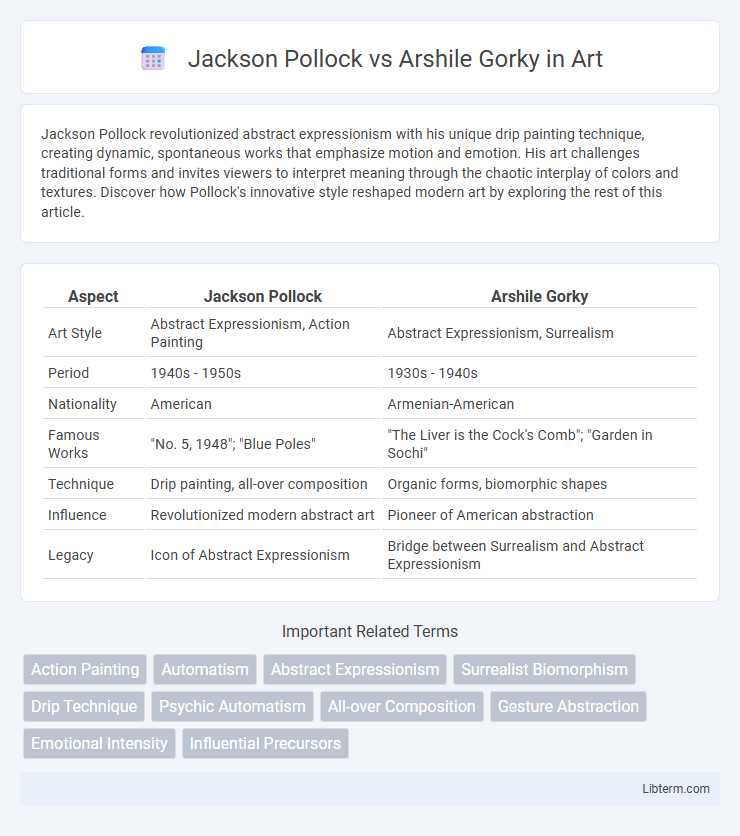Jackson Pollock revolutionized abstract expressionism with his unique drip painting technique, creating dynamic, spontaneous works that emphasize motion and emotion. His art challenges traditional forms and invites viewers to interpret meaning through the chaotic interplay of colors and textures. Discover how Pollock's innovative style reshaped modern art by exploring the rest of this article.
Table of Comparison
| Aspect | Jackson Pollock | Arshile Gorky |
|---|---|---|
| Art Style | Abstract Expressionism, Action Painting | Abstract Expressionism, Surrealism |
| Period | 1940s - 1950s | 1930s - 1940s |
| Nationality | American | Armenian-American |
| Famous Works | "No. 5, 1948"; "Blue Poles" | "The Liver is the Cock's Comb"; "Garden in Sochi" |
| Technique | Drip painting, all-over composition | Organic forms, biomorphic shapes |
| Influence | Revolutionized modern abstract art | Pioneer of American abstraction |
| Legacy | Icon of Abstract Expressionism | Bridge between Surrealism and Abstract Expressionism |
Introduction to Abstract Expressionism
Jackson Pollock revolutionized Abstract Expressionism with his innovative drip painting technique, emphasizing spontaneous, dynamic movement and emotional intensity. Arshile Gorky, often regarded as a bridge between Surrealism and Abstract Expressionism, infused his work with biomorphic forms and lyrical abstraction that profoundly influenced the movement's development. Both artists contributed uniquely to the emergence of Abstract Expressionism, shaping its emphasis on individual expression and abstract forms.
Early Life and Influences: Pollock vs Gorky
Jackson Pollock, born in Cody, Wyoming in 1912, was deeply influenced by Native American art and Mexican muralists, shaping his abstract expressionist style through the mentorship of Thomas Hart Benton. Arshile Gorky, born Vostanik Manoug Adoian in the Ottoman Empire in 1904, drew heavily from his Armenian heritage and surrealism, blending these influences with modernist techniques to create lyrical abstraction. Both artists' early exposures to distinct cultural and artistic environments significantly informed their pioneering contributions to mid-20th-century American art.
Artistic Styles Compared
Jackson Pollock's artistic style is defined by his pioneering drip painting technique, emphasizing dynamic movement, spontaneity, and abstract expressionism. In contrast, Arshile Gorky's work blends surrealism with biomorphic forms, integrating fluid shapes and emotional depth that foreshadow abstract expressionism. Pollock's large-scale canvases prioritize energetic chaos, while Gorky's compositions balance organic forms with a lyrical sense of structure.
Techniques and Mediums
Jackson Pollock revolutionized abstract expressionism with his drip painting technique, using enamel and oil-based paints on large canvases to create dynamic, layered compositions. In contrast, Arshile Gorky employed a more delicate approach, blending surrealism and biomorphic forms through oil paints on canvas, emphasizing fluid brushwork and subtle color transitions. While Pollock's work highlights energetic spontaneity and texture, Gorky's technique focuses on intricate detail and emotional depth using traditional oil mediums.
Signature Works: An Overview
Jackson Pollock's signature works, such as "No. 5, 1948," exemplify his pioneering drip painting technique, characterized by dynamic layering and abstract expressionism that revolutionized the art world. Arshile Gorky's key pieces like "The Liver is the Cock's Comb" showcase a blend of biomorphic forms and surrealist influences, serving as a bridge between European modernism and American abstract expressionism. Both artists significantly shaped mid-20th-century art, with Pollock emphasizing action painting and Gorky integrating personal symbolism and emotional depth.
Themes and Symbolism in Their Art
Jackson Pollock's artwork emphasizes abstract expressionism through dynamic drip painting techniques, symbolizing chaos and subconscious emotion. Arshile Gorky integrates surrealism and biomorphic forms, exploring themes of memory, identity, and trauma rooted in his Armenian heritage. Both artists use symbolism to evoke psychological depth, yet Pollock's work channels raw spontaneity while Gorky's conveys lyrical, introspective narratives.
Impact on Contemporary Art
Jackson Pollock's revolutionary drip painting technique transformed abstract expressionism by emphasizing spontaneous, dynamic movement and redefining the artist's role in the creative process. Arshile Gorky's fusion of surrealism and biomorphic forms introduced lyrical abstraction and deeply personal symbolism that influenced generations of contemporary artists. Both artists significantly shaped modern art by pushing boundaries of abstraction and emotional expression, creating enduring impact in galleries and art theory worldwide.
Critical Reception and Legacy
Jackson Pollock revolutionized Abstract Expressionism with his drip painting technique, earning acclaim for his dynamic, large-scale works that challenged traditional art forms. Arshile Gorky is celebrated for bridging Surrealism and Abstract Expressionism, his lyrical compositions influencing generations of artists despite his earlier critical struggles. Both artists left enduring legacies, with Pollock hailed as a symbol of American modernism and Gorky recognized for his profound impact on postwar art developments.
Personal Struggles and Their Art
Jackson Pollock channeled his battles with alcoholism and inner turmoil into his dynamic drip paintings, creating intense, chaotic compositions that visually expressed his emotional depth. Arshile Gorky, marked by the trauma of the Armenian Genocide and personal loss, infused his abstract works with surreal, biomorphic forms that evoke vulnerability and resilience. Both artists transformed profound personal struggles into groundbreaking abstract art, reflecting their unique emotional experiences through distinct stylistic innovations.
Conclusion: Comparing Their Lasting Influence
Jackson Pollock revolutionized Abstract Expressionism with his drip painting technique, creating a dynamic visual language that continues to inspire contemporary artists. Arshile Gorky, often considered a pivotal bridge between Surrealism and Abstract Expressionism, contributed profoundly to modern art through his emotive abstraction and biomorphic forms. Both artists left enduring legacies, with Pollock influencing gestural abstraction and Gorky shaping the emotional depth and lyrical qualities in 20th-century art.
Jackson Pollock Infographic

 libterm.com
libterm.com